This document provides an overview of the essential oils industry, including definitions of key terms, the nature and structure of the industry, major production regions and crops, and different business models for essential oil production. It discusses the supply chain from producer to end markets and provides statistics on the size and segmentation of the global essential oils and flavours/fragrances market. Production methods like wild collection, contract growing, and large-scale plantation models are examined.









































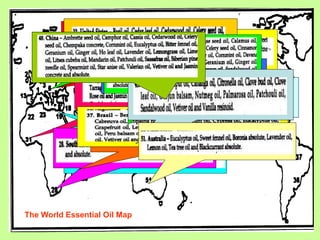












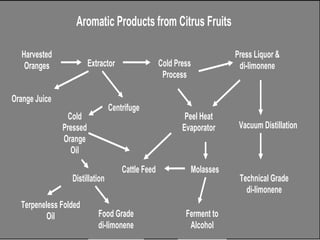





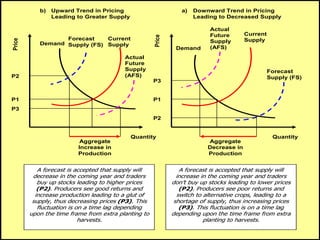


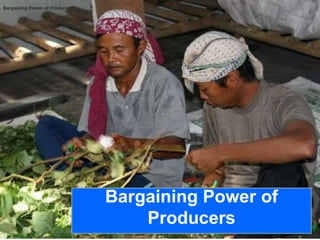




















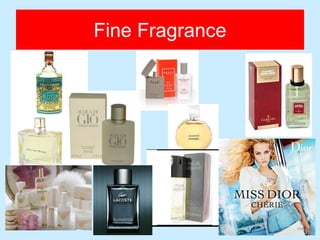









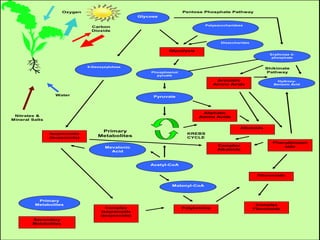








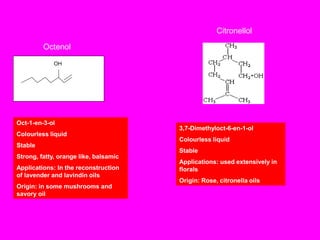



























































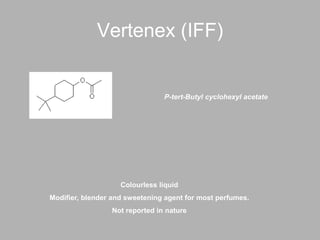
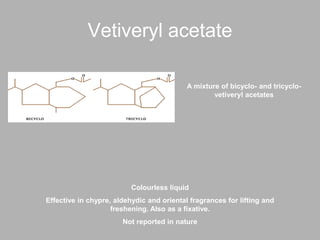




















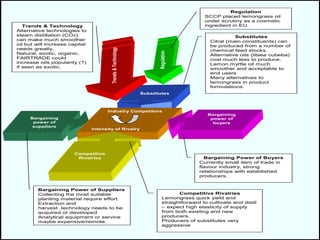






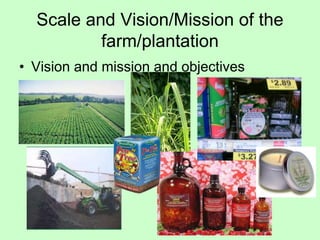










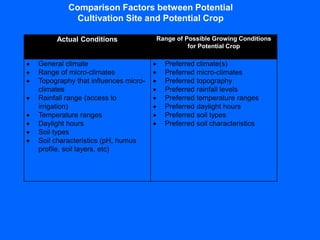



















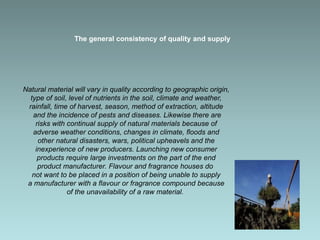

















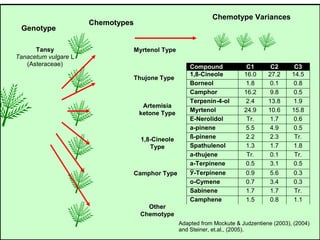

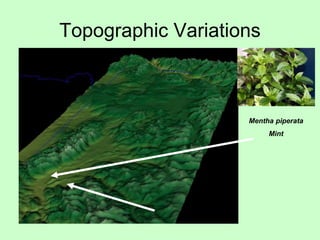









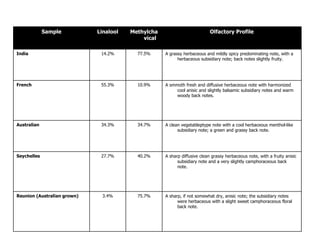








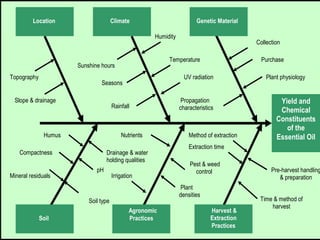





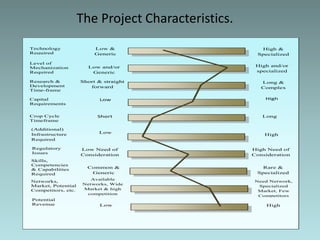
























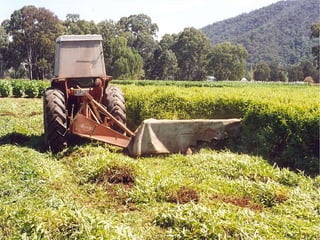




























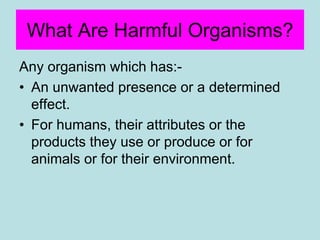
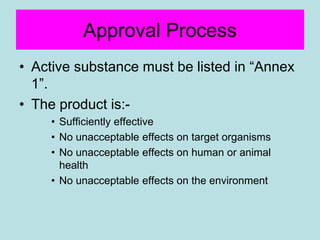














![Objectives at REACH
EU:-
“Regulation proposed by the commission
on 29 October 2003 achieves all the
objectives identified in the White Paper
and this represents a model of sustainable
development by pursuing objectives of the
three pillars:-
– Economic (industrial [ ])
– Social (health protection and jobs)
– Environment](https://image.slidesharecdn.com/essentialoilspresentationupdatedversionoct2011-221010172225-2079a53a/85/EssentialOilspresentationupdatedversionOct2011-ppt-339-320.jpg)











































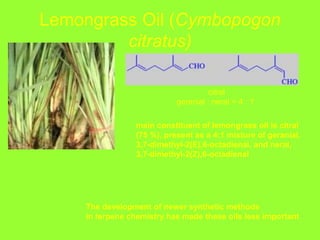



![Pandanus Oil (Pandanus
odoratissimus)
phenethyl methyl ether
pandanol
Origin: native of South East Asia and is much
cultivated on the Indian East Coast
The flowers are hydro-distilled to yield a 'kewda attar
phenethyl methyl ether (
pandanol) (38 %), together
with terpinen-4-ol (19 %),
alpha-terpineol (8 %) and
phenethyl alcohol (7 %) [79].
Phenethyl alcohol and its
derivatives are common
odorants in flowers](https://image.slidesharecdn.com/essentialoilspresentationupdatedversionoct2011-221010172225-2079a53a/85/EssentialOilspresentationupdatedversionOct2011-ppt-387-320.jpg)



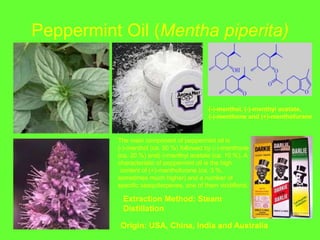











![Geranium (pelargonium species)
Potential High Value
Boutique Crop
Good for Hilly
Terrain
Citronellol, andgeraniol, which occur in different
proportions according to the origin of the oil. Both
Bourbon and North African-types contain unusual
high quantities of (-)-citronellol, isomenthone and
monoterpene formates. However they can be
distinguished by the presence of different
constituents such as guaia-6,9-diene in Bourbon
oil and 10-epi-[gamma]-eudesmol in the African-type.
The Chinese oil is similar to Bourbon-type,
having higher content of citronellol (+40%) and
lower content of Iinalool and geraniol (1,3).
Distillation or
solvent extraction
of the dried leaves](https://image.slidesharecdn.com/essentialoilspresentationupdatedversionoct2011-221010172225-2079a53a/85/EssentialOilspresentationupdatedversionOct2011-ppt-403-320.jpg)












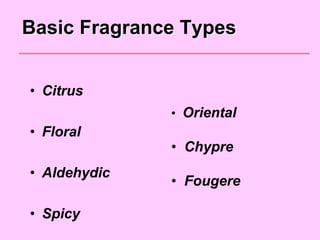












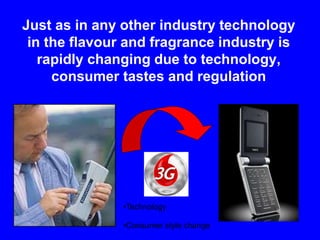





















![Plai oil (Zingiber cassumunar)
Major Constituents: terpinen-4-ol,
a-terpinene, sabinene, g-terpinene,
cis-3-(2',4',5'-trimethoxyphenyl
-4-[(E)-2''',4''',5'''-trimethoxy-styryl]cyclohex-
1-ene, cis-3-(3',4'-dimethoxyphenyl)-4-[(E)-3''',4'''-
dimethoxystyryl]cyclohex-1-ene, cis-3-
(3',4'-dimethoxyphenyl)-4-[(E)-2''',4''',5'''-
trimethoxystyryl]cyclohex-1-ene (3),(E)-4-
(3',4'-dimethoxypheny1)but-3-en-1-ol, E)-4-
(3',4'-dimethoxypheny1)but-3-en-1-yl acetate,
8-(3',4'-dimethoxyphenyl)-2-methoxynaphtho-
1,4- quinone
Sabinene and terpinen-4-ol
a-terpinene
g-terpinene
Extraction Method: Steam
distillation of the rhizomes](https://image.slidesharecdn.com/essentialoilspresentationupdatedversionoct2011-221010172225-2079a53a/85/EssentialOilspresentationupdatedversionOct2011-ppt-451-320.jpg)

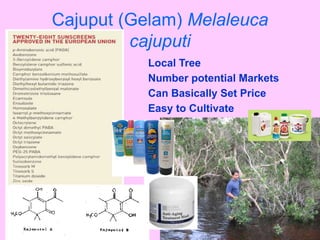
![Pandanus Oil (Pandanus
odoratissimus)
phenethyl methyl ether
pandanol
Origin: native of South East Asia and is much
cultivated on the Indian East Coast
The flowers are hydro-distilled to yield a 'kewda attar
phenethyl methyl ether (
pandanol) (38 %), together
with terpinen-4-ol (19 %),
alpha-terpineol (8 %) and
phenethyl alcohol (7 %) [79].
Phenethyl alcohol and its
derivatives are common
odorants in flowers](https://image.slidesharecdn.com/essentialoilspresentationupdatedversionoct2011-221010172225-2079a53a/85/EssentialOilspresentationupdatedversionOct2011-ppt-454-320.jpg)





